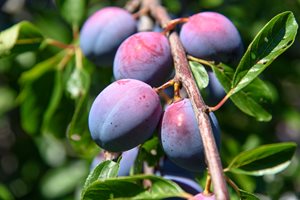
Plums are a delicious summer fruit you can use to make jams, puddings, cakes or add to gin! They’re versatile, tasty and a great addition to your kitchen and garden.
Growing plum trees is a rewarding experience. Follow the tips in our practical guide to grow and enjoy fresh plums from your trees.
How to plant plum pits
Growing a plum tree from a pit is an achievable and fun gardening project. Here's how to do it:
- Extract the seed: Remove the almond-shaped seed from a ripe, dried plum pit. You can test the seed to see if it's suitable for planting by putting it in a cup of water: if it sinks, you can use it. If it floats, throw it away.
- Cold stratification: This is a process that mimics winter conditions and helps the seed to germinate. Place the seed in a moist paper towel. Seal it in a plastic bag and refrigerate it at 1-4°C for up to three months or until a root emerges.
- Planting: After stratification, plant the seed in a well-draining pot filled with soil. Keep it in a warm, bright location with at least 6 hours of sunlight per day. Water the soil when it feels dry to the touch.
- Transplanting: Once the seedling has grown strong roots and several leaves, it can be transplanted into a larger pot or directly into the garden.
It can take several years for the plant to grow fruit, so it requires time and patience.
When to plant plum trees
In the UK, the best time to plant a plum tree outside is in the dormant season, around November to March (late autumn to early spring). This allows the tree time to establish roots before it grows in the warmer months in spring.
Bare-root trees, which are cheaper and more environmentally friendly, are available during the dormant period. However, container-grown, or potted plants, are available to plant all year round, though it's still better to plant them while the tree is dormant.
Always avoid planting when the ground is frozen or waterlogged, as plum trees do not thrive in these conditions. Choose a well-draining spot for your plum tree, ideally somewhere that receives ample sunlight.
How to grow plums from cuttings
It is possible to grow a plum plant from a cutting. Here's how:
- Take the cutting: The best time to take a hardwood cutting is in winter. Select a pencil-thin healthy branch from the previous year's growth and sever it diagonally around 10-15 inches long.
- Prepare the cutting: Remove any leaves and dip it into a rooting hormone to encourage root development.
- Planting: Insert the cutting into a pot filled with a damp but well-draining potting mix, making sure the bottom is covered. Keep the pot in a humid environment or a polytunnel to provide consistent moisture.
- Transplanting: Once firm roots have developed and a few leaves have grown, carefully transplant it to a larger pot or into the ground.
How long does a plum tree take to grow?
Patience is key when growing plum trees. A plum tree, depending on its size, typically takes anywhere from 1 to 5 years to start producing fruit, but the timeline can vary based on several factors:
- Rootstock: Trees grown on dwarfing rootstocks tend to grow smaller and bear fruit sooner, while those on more vigorous rootstocks take longer.
- Variety: Some plum varieties, like Victoria, are known for being fast-growing and can bear fruit in 2-3 years. Other varieties, such as damsons, take 3–5 years to mature.
- Planting method: Starting with a nursery-grown tree will result in quicker fruiting compared to planting seeds.
- Growing conditions: Plenty of sunlight, regular watering and balanced nutrients play a significant role in the tree's overall health and its ability to produce fruit.
How to grow plums in the UK with Premier Polytunnels
We have more than 35 years' experience providing high-quality, durable polytunnels that help people grow an array of plants. For the best results when growing young plum trees or dwarf varieties, consider using one of
our Premier Polytunnels to extend your growing season and create the optimal environment.
Polytunnels provide warmth and humidity to help dwarf or young plum trees stay strong and healthy, and protect them from diseases like plum leaf curl that are detrimental to their growth.
If you have any questions or need help deciding on the right products for you, don't hesitate to contact our team on 01282 811250 or drop us an email at
info@premierpolytunnels.co.uk.